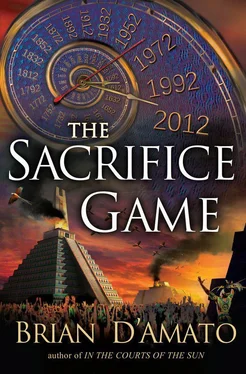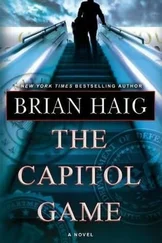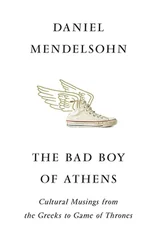Brian D'Amato - The Sacrifice Game
Здесь есть возможность читать онлайн «Brian D'Amato - The Sacrifice Game» весь текст электронной книги совершенно бесплатно (целиком полную версию без сокращений). В некоторых случаях можно слушать аудио, скачать через торрент в формате fb2 и присутствует краткое содержание. Жанр: Триллер, Исторический детектив, на английском языке. Описание произведения, (предисловие) а так же отзывы посетителей доступны на портале библиотеки ЛибКат.
- Название:The Sacrifice Game
- Автор:
- Жанр:
- Год:неизвестен
- ISBN:нет данных
- Рейтинг книги:3 / 5. Голосов: 1
-
Избранное:Добавить в избранное
- Отзывы:
-
Ваша оценка:
- 60
- 1
- 2
- 3
- 4
- 5
The Sacrifice Game: краткое содержание, описание и аннотация
Предлагаем к чтению аннотацию, описание, краткое содержание или предисловие (зависит от того, что написал сам автор книги «The Sacrifice Game»). Если вы не нашли необходимую информацию о книге — напишите в комментариях, мы постараемся отыскать её.
The Sacrifice Game — читать онлайн бесплатно полную книгу (весь текст) целиком
Ниже представлен текст книги, разбитый по страницам. Система сохранения места последней прочитанной страницы, позволяет с удобством читать онлайн бесплатно книгу «The Sacrifice Game», без необходимости каждый раз заново искать на чём Вы остановились. Поставьте закладку, и сможете в любой момент перейти на страницу, на которой закончили чтение.
Интервал:
Закладка:
The referees signed that it was legal. A big whooshing spitty whistley hiss rose out of the Ocelots and their partisans, the equivalent of applause, all breaking against a tide of stamping feet on the Harpy side, the more satisfying Maya equivalent of boos.
“T’un Bolom, kam-chen Bolomob,” the first chanter sang, that is,
“Goal, Ocelot, one-zero, Ocelots.”
The circles criers repeated the call, “T’un Bolom, kam-chen Bolomob.”
At the goal the players retreated behind their end-zone lines. A pair of untouchables ran in and caught the ball together with their gloved hands. One of them stood on the central marker, holding the ball, while the other purified it with a dusting of blood ashes out of a pouch. If the invisibles were like stagehands, the untouchables were a bit more like ballboys. But since they touched the court surface and the blood and the dead and most of all the ball, they were irrevocably polluted.
“Li’skuba ka.” Ready for Ball Two. I was getting that racehorse-at-the-gate feeling that I’d burst if I didn’t get out on the court. The first invisible faced west and threw the ball underhanded up into the air, expertly dropping it down on the Ocelots’ emerald-green rear marker.
“Chun,” the chanter called again. Emerald Immanent got the tip again and yoke-bounced the ball upward, controlling it-“ Bok” — and passed it gently off his shoulder arm.
“P’uchik,” the chanter called. The word both meant a hit on the body and imitated the sound of a ball hitting flesh and then snap-disengaging from oiled skin. Emerald Howler, the other Ocelot striker, caught the pass on the side of his yoke, “bok,” and knocked it ahead and right, angling it off the sloped masonry wall like in old-fashioned court tennis.
“Pak,” the cantor called, imitating the crisp solid sound. It was also the word for “wall.” Emerald Immanent had already run downcourt and positioned himself under the dropping ball for a shot at the target. The crowd noise fell to near silence and all you could hear was the warbling play-by-play chants and the players’ grunts and the squeaks and cracks of their sandals. It wasn’t that spectators weren’t allowed to talk, but that the game absorbed your total attention, even if you couldn’t see it happening. The crowd was so fascinated they actually shut up and let the intensity build until it was released in the paroxysm of applause at the end of a tense play, or a goal, or a death.
5-5 came up fast and blocked Emerald Immanent’s shot, but Immanent shifted, faded back, shoulder-passed back off the wall to Emerald Howler-“ P’uchik pak ”-who yoked it up perfectly up into the underside of the Harpy goal: “ Bok… t’un!”
“T’un Bolom,” the score-adder called, “wasak-chen Bolomob.”
“Goal, Ocelot, two-zero, Ocelots.”
Whistling blasted out of the crowd. It was two hundred beats later before the players settled into their positions and the head invisible served out the third ball. Emerald Immanent got it again and tried the same run-and-feint and back-pass to Emerald Howler, but this time Hun Xoc was there and he intercepted it, pulling the ball out of the air with his wrist-guard and sending it south to Red Beak. It was a signature move of the Harpy School. In most courts around here hipball was more like soccer, because you couldn’t touch the ball with your feet or your hands. But Ixian rules were a bit different, and we each wore a lizard-skin-wrapped wooden extension on the underside of our wrists, extending up into the palms, and you could bat or deflect the ball with those. Even so, the ball was so heavy you couldn’t get much force on it with your arms. And of course you weren’t allowed to catch it, not that you’d want to. Really, it was too heavy to launch seriously with anything but the braced weight of most of your body, and if it had any major momentum behind it you’d have to add some of your own as well. In your big yoke, which came nearly to the nipple level, and the roll of cotton padding peeking up over it, you felt gravity siphoning up through you, and as you received and launched the ball it felt like you were negotiating between a good-sized satellite and the pulling power of the earth. Sometimes you’d have to use your shoulder or calf or even upper arm, but you wouldn’t want to and no matter how hard you were you flinched against the weight. So the idea was to shoot with your hip-yoke whenever possible-which let you get your full weight behind the impact-and then to use your calf, shoulder, thigh, upper arm, and finally the palm guard, in that order of preference. Using your head would be a bad idea.
Red Beak kneed the ball south, low into the red expanse of the Harpy wall. Hun Xoc dove after it falling on his knees, blocking its rebound with the top angle of his ornate yoke. The ball settled down into the groove, reverberating between the wall and his yoke like a pinball caught between electric bumpers, the criers imitating the accelerating beat, “ pak, bok, pak, bok, pak-bok, pak-bok, pak-bok pak-bok pak-bok pakbok pakbok pakbokpakbok pakbokpakbokpakbokpakbok,” into a blur of sound. Hipball was a dignified game, a stolid ritual, an act of worship. But it was also a much faster game even than basketball, at least as fast as jai-alai or Ping-Pong.
Emerald Immanent recovered but Red Beak backed away from him into the Harpies’ end zone. The main territorial rule was that neither team was allowed into the other’s end zone, which in our case was the left half of the east half of the court, a red area shaped like a backward L. So in this match that meant the Ocelots couldn’t step on red and the Harpy clan couldn’t step on emerald. Each side’s blocker couldn’t leave the zone but the strikers could go anywhere but the enemy’s home quadrant. You couldn’t keep the ball in your zone for more than four bank- or body-bounces, though, and if the ball hit the level floor on your half of the court, it was out and you had to turn it over to the other team, but this hardly ever happened. The ball was too bouncy and the players were too good. Any one of these people could have body-juggled a cinder block and kept it in the air for scores of scores of scores of beats.
Red Beak waited for Hun Xoc to get between him and Emerald Immanent, and then took a slow run up toward the peg, working the ball with short flesh-dribbles onto the north wall. He shot and missed. Emerald Snapper got the ball and passed to Emerald Howler. Howler shot and missed and Hun Xoc got the ball. The deal was that it was nearly impossible to shoot for a goal from the enemy’s side of the center line, although “backward goals” and even error goals off the opposing team did happen. And since there was only one really good spot on your side to shoot for the opposing goal, the ball tended to follow a fairly set course. You’d gain possession, get the ball into position on your right side, and then charge up along the right bank, shooting ahead and up to the right at the other team’s peg. If you missed the peg, the opposing team would almost always gain possession. Then they’d do the same thing, they’d set up, make their own run and shoot for your goal, on your left side, and then you’d get the ball back and repeat the process. So even though there wasn’t a net, the design of the court itself created a back-and-forth motion and a general counterclockwise draw, like the endless left turn on a racecourse. And the same centrifugal force tended to keep the two teams separate, although not enough to prevent a clash or two. Despite how dangerous it was, it wasn’t really a contact sport, at least in theory.
Hun Xoc worked the ball up the north bank, “ bok, pak, bok, pak,” and suddenly took a long shot, like a three-pointer, sending the big black planet nearly into the Ocelot spectators’ baatob, and even though the ball seemed to miss the goal, it grazed the fragile jar of dyed marble powder. The jar wobbled and fell, trailing emerald-green plumes.
Читать дальшеИнтервал:
Закладка:
Похожие книги на «The Sacrifice Game»
Представляем Вашему вниманию похожие книги на «The Sacrifice Game» списком для выбора. Мы отобрали схожую по названию и смыслу литературу в надежде предоставить читателям больше вариантов отыскать новые, интересные, ещё непрочитанные произведения.
Обсуждение, отзывы о книге «The Sacrifice Game» и просто собственные мнения читателей. Оставьте ваши комментарии, напишите, что Вы думаете о произведении, его смысле или главных героях. Укажите что конкретно понравилось, а что нет, и почему Вы так считаете.












